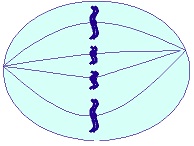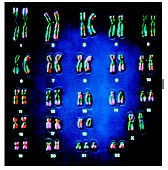Chromosomes and Inheritance
Response to the following question:
Part. 1: Gametes have half as many chromosomes as body cells.
1. is the process that results from the union of gametes from two different parents.
2. A skin cell is to a somate as a(n) ________ is to a gamete.
A) embryo
B) zygote
C) brain cell
D) egg
3. Determine whether each of the following cells is haploid or diploid.
A) An egg
B) A cell from your liver
C) A zygote
D) A sperm
E) A cell from your heart
4. A normal human egg or sperm has 23 chromosomes, which is exactly one half what a somate has. Briefly explain what would happen every generation if gametes were actually diploid.
5._________________contain the same genes at the same locations.
A) Sex chromosomes
B) Autosomes
C) Gametes
D) Homologous chromosomes
6. Are the two chromosomes shown here homologous? Briefly explain why or why not.

7. Can a karyotype be used to determine the gender of an individual? Briefly explain your answer either way. Hint - Look at the figure at the bottom part. 5-question.4
8. True or false: A situation where a human is missing an autosome is not fatal. If false, make it a true statement.
Part. 2: Meiosis produces gametes.
1. is the type of cell division that produces gametes.
2. A similarity that meiosis shares with mitosis is which of the following?
A) They both undergo chromosome duplication.
B) They both have two rounds of cell division.
C) They both occur in somatic cells.
D) They both have only one round of cell division.
3. Fill in the following table contrasting mitosis with meiosis.
|
|
Mitosis
|
Meiosis
|
|
Chromosomes duplicate prior to division?
|
|
|
|
Chromosomes condense prior to division?
|
|
|
|
How do chromosomes line up prior to division?
|
|
|
4. Is the dividing cell drawn in the following diagram in mitosis or meiosis? Assume the starting cell was diploid and had two pairs of chromosomes. Briefly explain your answer either way.

5. True or false: At the end of meiosis I, the two cells are both diploid. If false, please explain why.
6. At the end of meiosis II, there are ___ cells and they are all _________.
A) four; diploid
B) two; haploid
C) four; haploid
D) two; diploid
Part. 3: Mitosis and meiosis have important similarities and differences.
1. Mitosis is to a somate as meiosis is to a(n) .
2. List an example of a cell in your body that undergoes mitosis. How many chromosomes does that cell have?
3. Mitosis creates ________________, while meiosis creates _____________________.
A) haploid gametes; diploid gametes
B) diploid somates; diploid gametes
C) haploid somates; haploid gametes
D) diploid somates; haploid gametes
4. A cell biologist observes a cell under a microscope and determines that the cell contains nine chro-mosomes. Is this cell diploid or haploid? Briefly explain your answer.
Part. 4: Several processes produce genetic variation among sexually reproducing organisms.
1. The process of a sperm and an egg uniting is called __________________.
A) crossing over
B) independent assortment
C) fertilization
D) mitosis
2. Sexual reproduction produces a tremendous amount of diversity in organisms. List three ways in which this diversity is accomplished.
3. Each homologous pair of chromosomes can line up in one of two orientations. This kind of alignment is known as .
4. A biologist is studying cells from a new organism recently discovered in a rain forest. He determines that the somates contain a total of eight chromosomes. How many possible combinations of chromo-somes could this organism produce as a result of independent assortment? Assume the organism repro-duces sexually.
5. Briefly explain why the term crossing over is accurate for the process it names.
6. Crossing over produces ___________________________.
A) hybrid chromosomes
B) independent assortment
C) random fertilization
D) a zygote
7. Has the homologous pair of chromosomes in the following figure undergone crossing over? Explain your answer either way.

Part. 5: Mistakes during meiosis can produce gametes with abnormal numbers of chromosomes.
1. The failure of chromosomes to separate properly is known as .
2. True or false: Nondisjunction always results in a zygote with the incorrect number of chromosomes. If false, please explain why.
3. A human zygote is created from a sperm that contained an extra chromosome 21. How many total chromosomes did the sperm contain? How many chromosomes does the zygote have?
4. Does the individual from the karyotype shown here have a normal number of chromosomes? If not, what syndrome does he or she have?

5. Complete the following table regarding sex chromosome abnormalities.
|
Sex chromosomes
|
Syndrome
|
Sex
|
|
|
Klinefelter syndrome
|
|
|
XYY
|
|
|
|
|
|
Female
|
|
XO
|
|
|
6. An individual is determined to have Jacob's syndrome. Is it possible to determine which parent's gamete had the incorrect number of chromosomes? If so, which one was it? Briefly explain your answer ei-ther way.